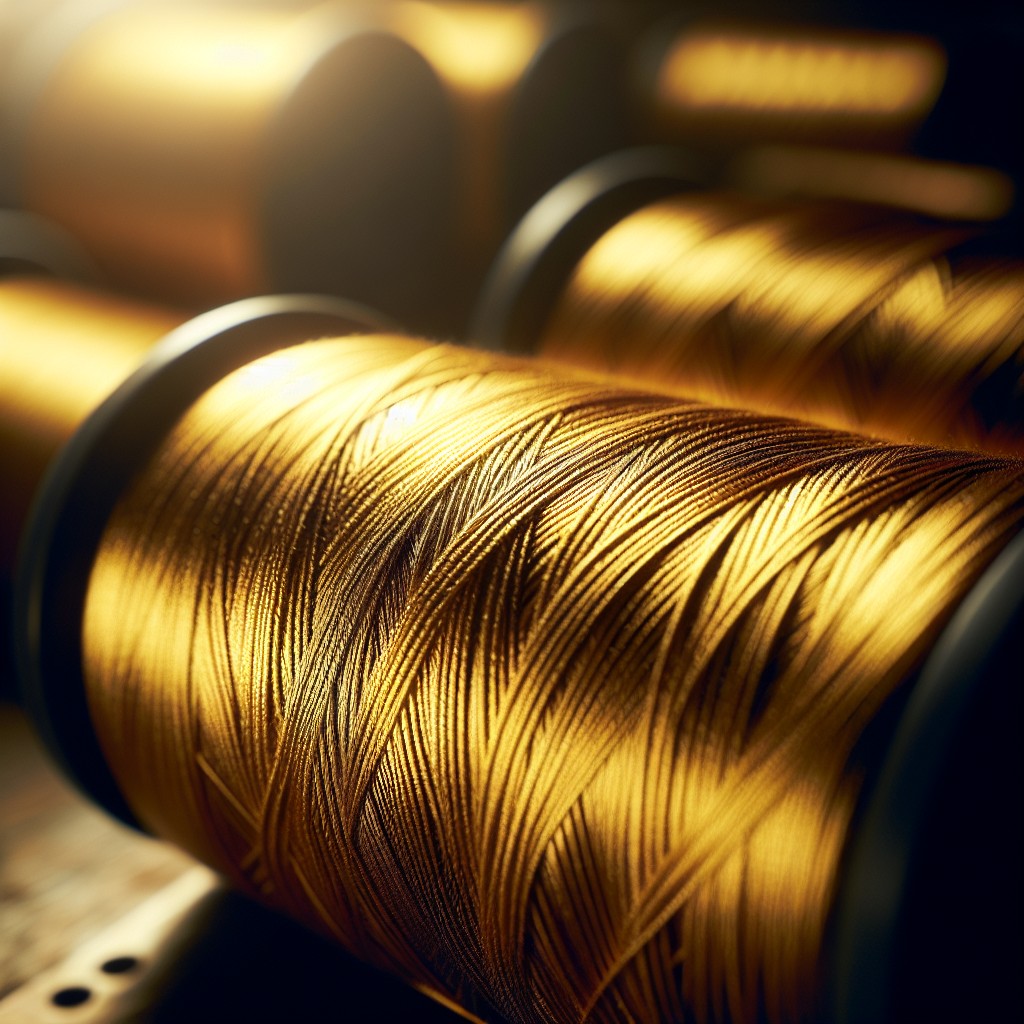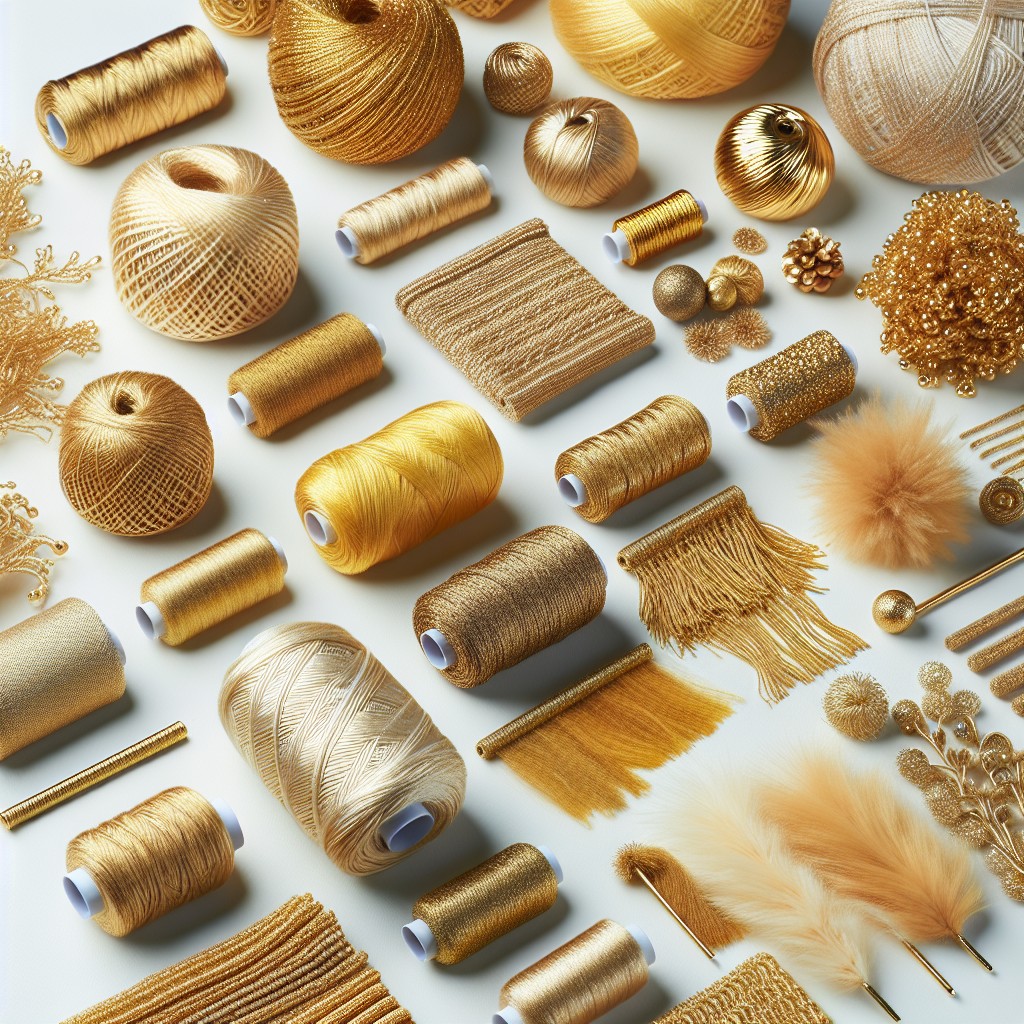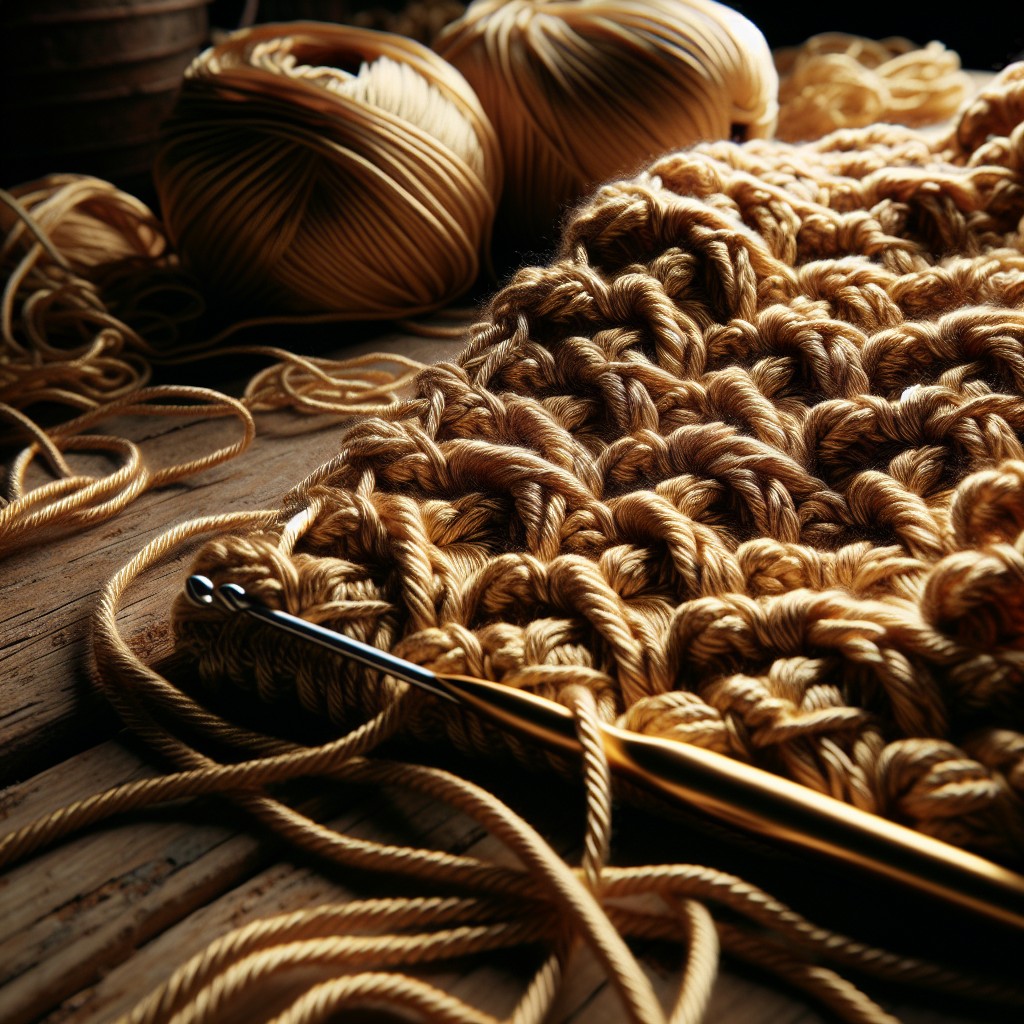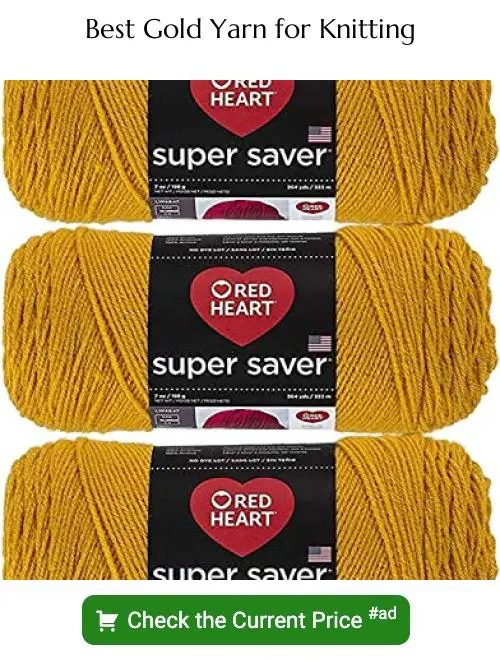Dive into the luxurious world of gold yarn because its versatile nature allows it to be used in countless creative projects.
Diving into the glamorous world of gold yarn, you’re bound to discover a dazzling array of possibilities. From its varying textures to its different types such as metallic, acrylic, or even spun with real gold, this fascinating material expands the horizons of knitting and crocheting projects.
Whether you plan to craft an elegant afghan or a festive holiday decoration, the beauty of gold yarn will definitely amplify your craft piece. This piece explores these different gold yarn varieties, their distinct characteristics, optimal care instructions, and the best projects they’re suited for.
Regardless of your crafting level or preference, this guide provides insightful details to ensure you select the ideal gold yarn for your next endeavor.
Key takeaways:
- Gold yarn is lightweight and delicate, requiring gentle handling.
- Different types include solid gold, gold thread, metallic gold, and gold-blended yarn.
- Use gold yarn in crochet for elegant patterns and pair it with complementary colors.
- When knitting with gold yarn, pay attention to tension and choose appropriate needles.
- Proper care, such as cold water washing and avoiding direct sunlight, maintains the shine.
Properties of Gold Yarn

Looking into the properties of gold yarn, we find that it’s generally lightweight and often incorporates synthetic fibers to achieve that striking metallic sheen. As it tends to be more delicate than other types of yarn, a gentle touch is necessary when weaving or knitting with it.
Several gold yarns on the market are blend fibers, mixing elements like cotton, silk, or wool with metallic threads. The presence of these natural fibers makes the yarn more manageable while knitting or crocheting, without sacrificing the glamour of that gold sparkle.
Furthermore, it’s available in various weights and thicknesses, catering to a range of projects from intricate lacework to chunky scarves or blankets. Its heat conductivity varies depending on the type and quantity of fibers blended, but it’s generally not as warm as 100% natural fibers.
Finally, gold yarn isn’t just about aesthetic appeal—it’s also durable. Despite its delicate appearance, it’s designed to withstand regular washing and wearing, provided it’s handled with care.
Different Types of Gold Yarn

Gold yarn, with its varying options, caters to numerous crafting projects. Primarily, these fall into four distinct categories.
1. Solid Gold Yarn: Typically rich and shiny, these purely gold-toned strands glisten spectacularly. They are an excellent choice when you want your work to be the center of attention.
2. Gold Thread: Delicate and subtle, gold thread is perfect for adding a hint of glamour to your crafts. It also works wonders for embroidery or embellishing finished pieces.
3. Metallic Gold Yarn: This variant incorporates a metallic thread, providing an intense shimmer. It’s ideally suited for festive crafts or luxury fashion wear.
4. Gold-Blended Yarn: This combines gold with other colors, resulting in a yarn that’s unique yet refined. It is perfect for those looking for a balance of sparkle and sophistication.
Not all gold yarns are alike. Their unique properties emanate from the use of different materials. Acrylic, cotton, and wool blends are common bases, with gold fibers or threads woven in.
Remember, each type has its particular strengths and best applications, so be sure to choose what works best for your project.
Incorporating Gold Yarn in Crocheting

Including gold yarn in your crochet masterpieces broadens the creative canvas by adding an elegant touch to your work. Here are some essentials to keep in mind:
1. Design Selection: Opt for patterns that complement the luxurious essence of gold yarn. Its shimmering characteristic enhances intricate stitches like shell or popcorn stitches.
2. Pairing with Other Yarns: If you’re working with gold yarn alongside other colors, select hues that elevate its radiance. Blacks, whites, and jewel tones typically work well.
3. Single Crochet: For beginners, the single crochet stitch is an excellent starting point to showcase the gold yarn’s sheen without getting lost in complex constructions.
4. Thread Weight: Depending on thread weight, gold yarn can hold beautiful shape in doilies or be woven into lavish afghans. Remember, the greater the weight, the sturdier the item will be.
5. Hook Size: Pick a corresponding hook size that accentuates your stitch design. A smaller hook can help produce a dense, warm fabric, while larger hooks can yield a more draped, open weave.
6. Light Effects: Keep in mind that the metallic sheen of gold yarn is accentuated by light. Therefore, gold yarn pieces can look especially striking under lamps or sunlight.
Although working with gold yarn can be slightly trickier than regular yarn, the breathtaking beauty in the finished work is invariably worth the effort.
Working With Gold Yarn in Knitting

When knitting with gold yarn, there are some crucial considerations for quality results. Firstly, due to its unique characteristics, consistently monitoring tension is vital. Too tight and the shine and drape may be compromised. Too loose and the result may appear disheveled.
Secondly, choose a needle that complements your yarn’s weight. A smooth, non-snagging needle such as bamboo or aluminum is ideal.
Lastly, adorn your knitting with caution. Because gold yarn is striking, intricate patterns may get lost. A simple stitch pattern often complements gold yarn well, letting the yarn itself be the star.
Now, let’s move to dealing with common issues in using gold yarn.
Maintaining the Shine of Gold Yarn
To keep that dazzling luster of the gold yarn intact, it’s essential to follow a few maintenance tips.
Firstly, always use cold water when washing items made from gold yarn. This helps to prevent the threads from losing their metallic glimmer.
Secondly, rather than wringing out excess water, gently squeeze the fibers. This gentle treatment helps to prevent any physical damage.
For drying, avoid direct sunlight as it can potentially fade the golden shine. Lay out the item flat on a clean towel to air dry. If you’re using a washing machine, make sure to set it to a gentle cycle and put your knitted or crocheted items inside a mesh laundry bag for extra protection.
Avoid using harsh chemicals or bleach as these can discolor and damage the yarn. If you’re opting to use a fabric softener, ensure it’s mild and clear. It’s also a good idea to check the washing instructions given by the yarn manufacturer on the label, as these can vary.
Regular dusting of your gold yarn projects with a soft brush can help to keep them shining. This simple routine can immensely retain the yarn’s sparkle, keeping your creations as stunning as ever.
Caring for Garments Made From Gold Yarn
To ensure your gold yarn items last longer and keep their sparkle, follow these key steps.
First, hand wash your pieces gently in cold water – this protects the color and prevents any misshaping.
Refrain from wringing out excess water as it can distort the item’s shape.
Instead, press out the water gently, or roll the item in a clean, dry towel.
Next, for the drying process, lay flat on another dry towel, carefully shaping it to its original form.
This will help retain the piece’s structure and design.
Avoid direct sunlight or any heat source to prevent discoloration or the yarn becoming stiff or scratchy.
Lastly, in most cases, ironing is not necessary or recommended for yarn-crafted items as the heat can damage the fibers.
If you must remove wrinkles, use a steamer, and keep it at a safe distance.
By sticking to these guidelines, you can preserve your crafted pieces impeccably and enjoy their beauty for years to come.
Gold Yarn Brands and Where to Buy Them
Renowned for its striking hue and shimmer, Lion Brand Shimmering Gold and Red Heart Gold are exceptional choices, available online for crafters around the world. Alternatively, for those seeking eco-friendly choices, the Debbie Bliss Eco Baby Fair Trade Collection includes a radiant golden shade.
Local yarn stores offer diverse selections, too. It is always advised to check the availability before visiting. This helps to not only save on time but also ensures you find the desired gold yarn quality.
Lastly, never underestimate the power of online marketplaces like Etsy or eBay. They offer an extensive range of hand-dyed gold yarns from independent suppliers, perfect for those who prefer a unique touch to their creations. Always check seller reviews before making a purchase to ensure the quality and reliability of the product.
Choosing the Right Gold Yarn for Your Projects
Selecting the perfect gold yarn for your upcoming endeavor depends on a few important factors.
1. Project Type: Gold yarn lends itself well to glamorous and ornate items such as shawls, evening bags, and special occasion garments.
2. Yarn Weight: Lighter weights are ideal for delicate, lacy patterns, while heavier weights work best for robust and cozy items, including blankets and rugs.
3. Fiber Content: Consider if you want a glittery effect or a more subdued sheen. Metallic blends offer sparkle, while natural fibers in a gold hue offer a toned-down alternative. If you’re seeking comfort, avoid scratchy pure metallics and opt for a blend with soft fibers.
4. Yarn Texture: Smooth yarns produce crisp stitch definition, while textured yarns provide a more rustic look.
5. Pricing: Gold yarns vary greatly in cost, from budget-friendly acrylic blends to luxurious, hand-spun options.
6. Washability: Check the care instructions. Some gold yarns may be machine-washable, while others may require hand washing and drying flat.
Remember, the key is to choose a gold yarn that aligns with the specific demands of your project and your personal preferences, ensuring a satisfying and successful crafting experience.
Weight of Gold Yarn
Gold yarn comes in various weights, each suiting different types of projects.
1. Lace Weight: Ultra-thin, this choice is excellent for delicate shawls and light, graceful garments. It’s perfect for intricate lace patterns to highlight your exceptional attention to detail.
2. Fingering Weight: Typically used for making socks, scarves, and other light garments, this weight is incredibly versatile.
3. DK (Double Knit) Weight: This medium weight is great for creating warm and cozy blankets, sweaters, and other cold-weather essentials.
4. Worsted Weight: Ideal for home decor items and heavier winter wear. As the heavier gold yarn, it is handier for beginners due to its structure and ease of handling.
5. Bulky Weight: Ideal for rugs, blankets, or heavy sweaters. As it knits up quickly, it’s perfect for those time-sensitive projects.
Keep in mind that the project you choose will dictate the weight of the yarn needed. Always consider this when selecting your gold yarn to ensure the right fit, feel, and outcome for your unique creation.
Fiber Content of Gold Yarn
The fiber content greatly influences the texture, durability, and practicality of gold yarn. Many options are available to choose from when selecting gold yarn for your next project.
Here’s a quick guide on each type:
- Acrylic: It’s widely used due to its affordability, high durability, and its ability to retain its gold color well. It is machine washable, making it an excellent choice for projects that require regular cleaning.
- Wool Blends: This gold yarn is typically mixed with other synthetic fibers to boost strength and durability. It imparts a warm, soft feel to your creations but requires special care when washing to avoid shrinkage.
- Metallic Thread: Comprised of a synthetic core wrapped in a metal coating, this yarn provides a high-shine, festive look to your projects. But, it might not be the best choice for wearable items due to its less flexible texture.
- Cotton: Ideal for warm weather projects, this yarn is soft, breathable, and can hold golden dye well. However, it lacks the fluffiness of other yarn types.
Remember, each yarn type will lend its unique qualities to your finished product, so select carefully based on the characteristics you desire in your handmade creation.
Yarn Lines That Offer Gold Yarn
Several yarn lines cater to the demand for gold yarn, offering a range of hues, textures, and weights. Lion Brand, for example, boasts an array of gold in their collections, such as the metallic gold in their “Vanna’s Glamour” line. Caron Simply Soft features “Gold” and “Autumn Maize,” giving options for those looking for a warmer palette.
Red Heart Super Saver additionally offers multiple variations of gold, with tones ranging from a deep, rich gold to a light, yellow-gold, suitable for any project. For luxury seekers, Rowan’s “Pure Wool Worsted” gold brings a touch of elegance to craft pieces.
Cloverhill Yarn Shop also features hand-dyed gold yarns, perfect for unique, one-of-a-kind creations. Remember to check the weight and texture, ensuring the yarn fits your project requirements. More importantly, check if the yarn line matches your preferred crochet or knitting technique for optimal results.
Review of Different Gold Yarn Brands
Diving into the diverse realm of yarn brands, let’s explore a few popular options for gold yarn.
Lion Brand’s “Vanna’s Glamour” line offers a lovely sheen to your work. This lightweight, metallic yarn is perfect for both crocheting and knitting holiday decorations or evening wear.
Red Heart’s “Shimmer” line is another fantastic choice. Despite being a gold yarn, its subtle sparkle doesn’t overwhelm. Combined with its easy-to-work nature, it’s terrific for beginners.
Cascade’s “Luminosa” is a luxury alpaca blend yarn that features a jewel-tone tweed effect on a base of gold. It’s well-suited for garments or accessories that require a touch of elegance.
Caron’s “Simply Soft Party” yarn provides a burst of sparkle with its strand of metallic thread. It’s ideal for knitting or crocheting party-ready hats, scarfs, or sweaters.
Valley Yarns’ “Charlemont” is a beautiful fingering weight yarn. Its gold variant exudes a rich, warm hue, excellent for creating intricate patterns and designs.
Take these options as starting points and explore what each one brings to your crafting table.
Understanding the Label of Gold Yarn
Deciphering the label on a skein of gold yarn can initially seem tricky. However, it’s actually quite the information hotspot!
1. Look for the weight: This indicates the thickness of the yarn. It could be lace, fingering, sport, DK, worsted, bulky or super bulky. The weight significantly affects your project’s size and appearance.
2. Find the fiber content: This reveals what the yarn is made of. Most gold yarns are synthetic or a blend of various fibers. This information helps in understanding its care instructions, durability, and texture.
3. Gauge is key: Stated on the label, the gauge tells you the recommended stitches per inch using a specific needle size. This is critical for ensuring your finished product is the correct size.
4. Care instructions: These are the washing and drying guidelines. Hand-washing and flat-drying are common for luxurious gold yarns to maintain their luster.
5. Dye lot number: This number denotes a batch under which the yarn was dyed. Uniformity in color is essential in a project, so assure all yarn comes from the same dye lot.
By understanding these label elements, you’ll be well-equipped for a successful, radiant gold yarn project.
Creating Textural Effects With Gold Yarn
A variety of stitches can amplify the visual impact of gold yarn. Think about using cable stitches in knitting or puff stitches in crocheting, as they can add depth and dimension, enhancing the unique shiny attribute of gold yarn. While using complex stitches, it’s beneficial to keep the pattern simple since the shine of the yarn should be in the focus.
Remember, a single strand of gold yarn can be effectively used alongside other yarn colors for highlighting purposes. Combining gold yarn with neutral tones, for instance, can create a striking contrast, and allows the gold to truly shine.
For subtle glimmers, consider using gold yarn as a secondary material, weaving it sparingly into the pattern. This creates a sophisticated design with a touch of sparkle.
Finally, let’s not forget about the variety of techniques you can employ. An exciting approach is the use of double-ended crochet hooks, mastering the Tunisian simple stitch which creates a dense, rich texture, a perfect match for the intensity of gold yarn.
Common Projects for Gold Yarn Use
Gold yarn, with its luminescence and rich hue, can be used to elevate many crafting projects, transforming them from simple pieces to eye-catching creations.
1. Accent Pieces: One common use of gold yarn is creating accent pieces in larger crochet or knitting projects. It adds a visual interest in afghan throws, shawls, or caps.
2. Jewelry: The metallic gleam of gold yarn makes it ideal for crocheting or knitting bespoke pieces of jewelry, such as necklaces, bracelets, or earrings.
3. Holiday Decorations: Its festive aura makes gold yarn the perfect choice for holiday knitting or crocheting projects like Christmas ornaments or decorative Halloween spiders.
4. Glittery Amigurumi: Gold yarn is excellent for crafting glitzy amigurumi. These little knitted or crocheted creatures look quite delightful when crafted using gold threads.
5. Embellishments: Gold yarn is perfect for adding glitz to the mundane items like plain headbands, scarf edges or designing brooches and hair clips.
Remember to choose your project based on the weight and texture of the yarn, as these will greatly impact the final product’s look and feel.
Dealing With Common Issues in Using Gold Yarn
As with any yarn, gold yarn can present its own set of challenges. Let’s dive into some tips to overcome them.
Firstly, gold yarn can be more slippery than other types, making it more prone to falling off the needles. Using bamboo or wooden needles, which have more grip, can help avoid this problem.
Secondly, its metallic threads can sometimes cause the yarn to split while working. A crochet hook or needle with a rounded tip can prevent splitting by pushing the threads together rather than separating them.
Thirdly, gold yarn might lose its shine over time or even tarnish. To prevent this, consider laying the finished project flat to dry after washing rather than using a dryer.
Lastly, similar to other metallic yarns, gold yarn can be a bit stiff. To achieve a softer drape for clothing items, you could opt to carry the gold yarn along with a softer yarn in a matching color. This strategy also works particularly well when the gold yarn is too thin for your desired project.
Remember, patience is key when dealing with gold yarn, but the stunning results are well worth it. Keep these tips in mind to tackle common issues, and you’ll find that working with gold yarn can be as rewarding as it is visually striking.
Preventing Tangling or Snags When Using Gold Yarn
To mitigate the risk of tangling or snagging gold yarn, employ the following strategies:
- Use Yarn Bowls: These prevent the ball from rolling away and getting tangled. Its smooth interior ensures the yarn feeds out without snagging.
- Adopt a Proper Yarn Holding Technique: Hold your yarn in a way that it can freely move through your fingers. This prevents unwanted tension which could lead to snags.
- Use Appropriate Tools: Gold yarn usually has a metallic sheen and can snag on rough surfaces. So, consider using tools like satin coated crochet hooks or knitting needles.
- Mind Your Yarn Tension: Tug gently on your yarn when crocheting or knitting. Pulling too hard might cause it to knot or snag.
- Store Correctly: After each work session, make sure to safely store your yarn. A loose end could tangle easily, so either thread it back into the ball or use a yarn bobbin.
Remember, patience is key when working with gold yarn. Its qualities provide an aesthetic payoff that’s worth the extra care.
Storing Gold Yarn Properly
For longevity, it’s crucial to store yarn properly. To prevent damage and keep your golden hues as vibrant as the day you bought them, follow these tips.
1. Avoid Direct Sunlight: Direct exposure to sunlight over a period can cause gold yarn to fade. It’s best stored in a shaded place.
2. Store in Cool, Dry Place: Moisture is yarn’s enemy. It can lead to mold and mildew, damaging your precious gold yarn. Keep the yarn in a cool and dry place.
3. Use a Storage Bag: Opt for a breathable fabric bag to store gold yarn. This will protect it from dust while allowing the yarn to breathe.
4. Keep Away from Pets: Curious pets, especially cats, may get into your yarn. Keep it stored in a secure place where they can’t reach.
5. Use Mothballs for Long-Term Storage: If you’re storing gold yarn for an extended period, consider using mothballs to prevent insect damage. However, remember to air the yarn before use to remove any lingering smells.
These tips help you preserve your gold yarn’s glamour, ready to lend its shine to your next project.
FAQ
What is the most expensive yarn in the world?
The most expensive yarn in the world is produced from vicuña wool, which costs between $400 to $600 per kilo in its unprocessed state.
What happened to Red Heart website?
The Red Heart website has been migrated to Yarnspirations.com, where you can access the same account information, past orders, and Wishlist items by resetting your password.
What is number 1 weight yarn?
Number 1 weight yarn, also known as fingering weight yarn, is a superfine type of yarn ideal for creating items such as shawls, baby clothes, hats, bags, and lightweight scarves.
Why is yarn getting expensive?
Yarn prices have surged due to factors such as high demand, increased costs for raw materials and energy, diminished production, and struggles within the global supply chain.
How can one distinguish authentic cashmere from synthetic types?
One can distinguish authentic cashmere from synthetic types by conducting a touch test, with real cashmere being significantly softer and warmer, observing color vibrancy as natural cashmere tends not to be overly bright, and by doing a pilling test where authentic cashmere will have minimal pilling compared to synthetics.
What are the recommended storage techniques for precious yarns to prevent damage?
Recommended yarn storage techniques include keeping yarn in breathable cotton bags to prevent moisture buildup, storing in a cool, dry, and dark place to avoid sun damage and dampness, and using cedar or lavender to ward off pests.
What is the process of creating hand-spun yarns from exotic fibers like qiviut and vicuna?
The process of creating hand-spun yarns from exotic fibers like qiviut and vicuna involves cleaning and carding the raw fiber, spinning it into a thread using a spindle or spinning wheel, and then plying multiple threads together to achieve desired thickness and strength.





